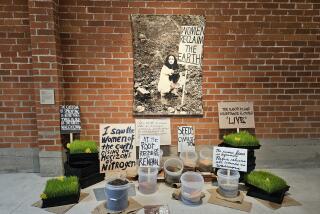Rite Angles in Africa
- Share via
When Carol Beckwith and Angela Fisher met in Kenya in 1978, it was a meeting of minds as well as purpose. Both had traveled alone for years, photographing traditional African customs and ceremonies.
Their encounter sparked decades of travel together and a collaborative ethnographic project that culminates in an exhibit opening Friday at the House of Photographic Art in San Juan Capistrano.
Last fall, after the two lectured at the Bowers Museum of Cultural Art in Santa Ana, Peter Keller, the museum’s director, suggested an exhibit of their African pictures at the photographic museum.
HOPA director Maryanne Charis invited the two artists to be among the first featured at the photographic museum, which opened in May 1999.
The exhibit, “African Ceremonies,” together with a new two-volume book by the same name published by Abrams, distills decades of photographs documenting a part of Africa that is rapidly vanishing.
The two women have photographed ceremonies in 26 countries. The rites they’ve witnessed have included the virtually extinct initiation for Masai warriors in Kenya and the Karo tribe’s courtship dance in southwestern Ethiopia.
“We’re all aware of the drought, the upheaval, but not these cultures, some of which are more than 1,000 years old,” Beckwith said, adding that some of the ceremonies had never been recorded before.
Fisher, born in Australia, graduated from Adelaide University with a degree in social science. In 1970, she moved to Kenya and began studying the jewelry and body decorations of African people. She worked 14 years in the field, traveling 28,000 miles across the continent by mule, on horseback, by dug-out canoe, by four-wheel drive and on foot.
Beckwith graduated from Boston Museum School of Fine Arts in painting and photography. In 1974, she too moved to Africa. Fluent in Fulfulde--the tongue of the Wodaabe nomads of western Africa--she lived with the Maasa of Kenya and Tanzania.
The two photographers, both in their early 50s, work in Africa seven to 10 months a year and consider the continent their home. The rest of the year they give lectures and visit friends and family in Europe, the U.S. and Australia.
They once were invited to watch healing and exorcism rituals as they traveled with a Himba healer in northern Namibia. The three women journeyed by foot, often sleeping under the stars. In one village, they were told that a man had been killed by a lion and that his three wives were possessed by a lion spirit.
“They were crawling on the ground, growling and snarling,” Beckwith said. “We watched [the healer] take the spirit out of them. . . . She then whispered to us to take her home to her ancestral fire, and she wrestled with that spirit from 2 p.m. to midnight.
“Then suddenly we saw a flash of light spring from her cheek, and the spirit had left.
“When we got to London, we had captured the exact moment on film. We can’t explain it, but we had it on film,” Beckwith said. “It’s one of the most amazing things I have seen.” The photo is included in the museum show.
The two were sometimes invited to return to a village to record a seldom-performed ceremony.
They would travel with nomads and their camels, sometimes waiting months for the ceremony to take place.
“Many nomads don’t use a calendar,” Beckwith said. “We learned to understand African time, to live in harmony with the seasons.”
The two take joint credit for all the work, regardless of who shot the individual picture. As Beckwith explained, many pictures were possible only because of their collaboration. “If things were happening simultaneously, we were stronger than if there had been only one of us.”
What drew Beckwith and Fisher to traditional African culture was the utilitarian nature of its art--that art was created not to decorate a wall but to be worn and used.
“In Tanzania, when I met the Masai for the first time, I felt an amazing sense of excitement in the heart,” Fisher said. “It was like walking into a dream. They were so beautiful, an inspiration to your own life.”
The masks, robes and headdresses also have symbolic value, signaling the stages of a person’s life, Fisher said.
“You could tell if a woman had just been widowed because she would wear a particular necklace.”
And, Fisher noted, if you saw a man wearing a pink beaded corset, “you could tell he was ready to get married.”
The two hope by their exhibit to open people’s eyes to the beauty of Africa as well as to impart a serious message about a part of Africa that is disappearing.
“Around 20% of the ceremonies in the book have changed or no longer exist because of the onrush of the modern world,” Beckwith said. “We would hope that traditional African peoples can make the transition--but by keeping their values intact. It’s the richness of these values that give life a special meaning in Africa.”
*
“African Ceremonies” opens Friday and continues through April 15 at the House of Photographic Art, 27182 Ortega Highway, San Juan Capistrano, (949) 496-5127. Carol Beckwith and Angela Fisher will give a lecture and slide presentation at 1:30 p.m. Saturday in the museum. Admission is free. The museum is open Tuesday through Saturday from 10 a.m. to 4 p.m. by appointment.


